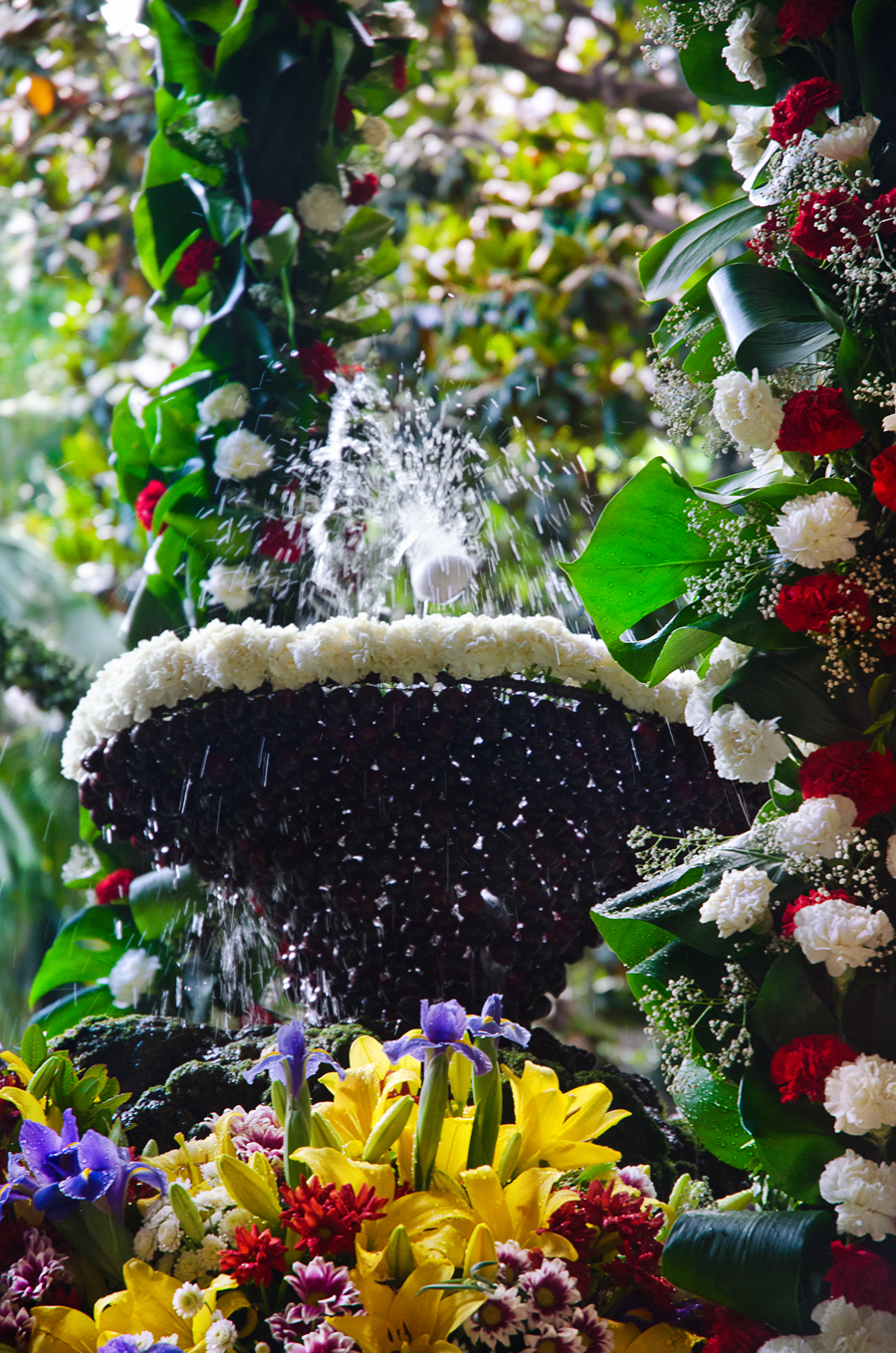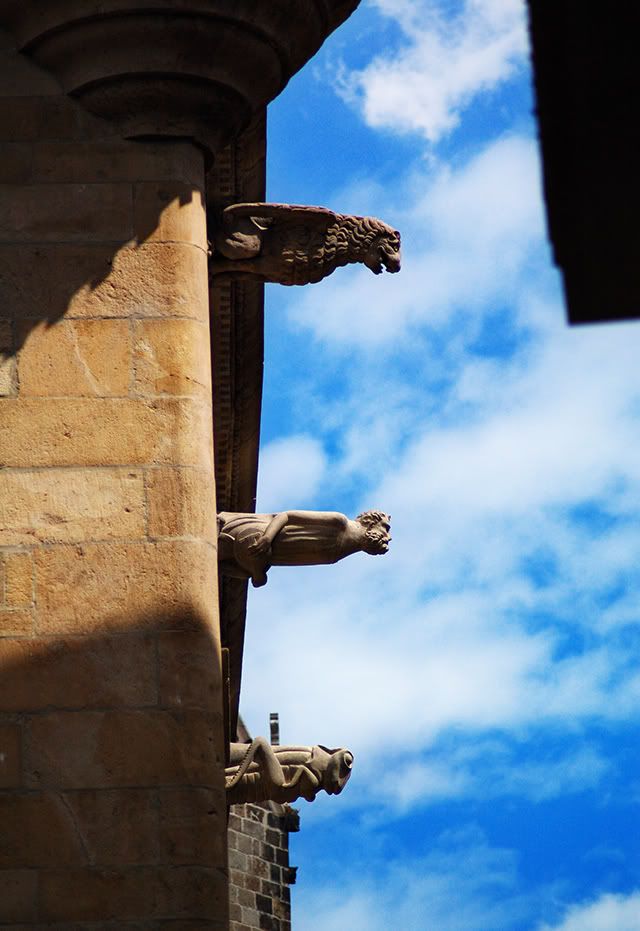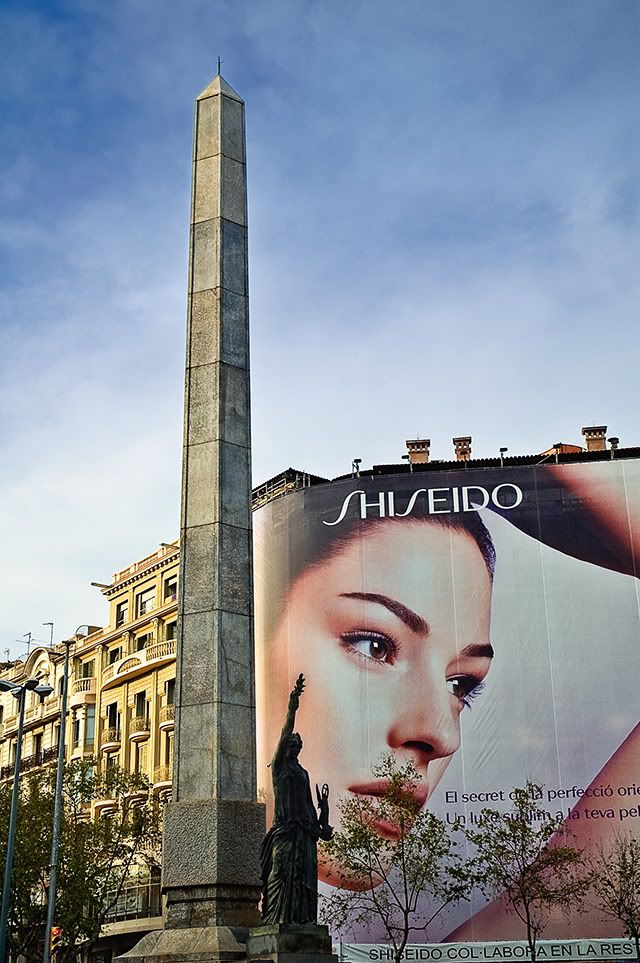There are numerous good samples of the Roman past of Catalonia throughout our geography. This Roman temple from II a.c in the city of Vic is not precisely the best example since it underwent two important restorations but the fact is that at least part of a column shaft and the Corinthian capitals on the right hand side of the entrance are authentic. What is certainly special about this temple is that it was discovered in 1882 while demolishing the old Montcada's family castle who lived there in XI century. In IX c. Guifré el Pelós decided to integrate the old VIII c. fortress it had been during Saracen times, into a castle.
Barcelona photos: Daily photographs of Barcelona, Spain. Pictures of a modern city with travel tips in a personal photoblog. A photography and travel site. Art, architecture, people and traditions. Travel to Barcelona through my camera, know more about our city and towns nearby. Welcome!
Wanna be featured?
Showing posts with label history. Show all posts
Showing posts with label history. Show all posts
February 19, 2012
January 29, 2012
L'Ou Com Balla or The Dancing Egg, Barcelona Cathedral
 |
| L'Ou Com Balla tradition at Barcelona Cathedral, Barri Gotic, Barcelona |
In the cloister of the Cathedral of Barcelona there is a beautiful fountain decorated with flowers that reminds you of idyllic gardens, of some paradise lost on earth.
It is the Sant Jordi fountain. Surfing over the soft cushion of its water jet once a year you can see a fragile eggshell that seldom falls which is called the L'Ou Com Balla, which translated literally from Catalan means how the egg dances or how dances the egg.
This is not the only place in Barcelona where you can find a dancing egg (there's one a la Casa de l'Arcadia or at Museum Frederic Mares' courtyard for example) but I think this is the one with more tradition, a tradition that goes back to the XIVth century and has to do with Corpus Christi celebrations, the eggshell itself representing the body of Christ.
The exact date to see L'Ou com Balla changes but it takes place at the end of May or in June depending on Corpus Christi Feast.
It is the Sant Jordi fountain. Surfing over the soft cushion of its water jet once a year you can see a fragile eggshell that seldom falls which is called the L'Ou Com Balla, which translated literally from Catalan means how the egg dances or how dances the egg.
This is not the only place in Barcelona where you can find a dancing egg (there's one a la Casa de l'Arcadia or at Museum Frederic Mares' courtyard for example) but I think this is the one with more tradition, a tradition that goes back to the XIVth century and has to do with Corpus Christi celebrations, the eggshell itself representing the body of Christ.
The exact date to see L'Ou com Balla changes but it takes place at the end of May or in June depending on Corpus Christi Feast.
Labels:
barcelona cathedral,
barri gotic,
Catalan traditions,
culture,
folklore,
gothic quarter,
history,
religion
Location: Barcelona, Spain
Pla de la Seu, s/n, 08002 Barcelona, Spain
January 17, 2010
Francesc de Paula Rius i Taulet by Manuel Fuxa and Pere Falques
Walking down Passeig Lluis Companys towards Parc de la Ciutadella right at the opposite site of Arc de Triomf we find a monument that honors city mayor Francesc de Paula Rius i Taulet. This obelisk was built between 1897 and 1901 by sculptor Manuel Fuxà with the help of architect Pere Falqués. The universal exhibition of 1888 held in Barcelona had a significant impact on the economic, cultural, demographic and urbanistic development of the city and much of such improvement is owed to Rius i Taulet as president of the event and as promoter of many projects started as a result of the exhibition. Notice the man with hammer on his left that symbolizes Labor and a lady paying homage to the mayor on behalf of the city.
December 23, 2009
Cogwheels: Industrial Reminiscence of Catalonia's Past
Cogwheels that evoke the times of industrial revolution in Europe, times of textile factories in Catalonia, of heavy machinery, of steam and rising unions, of a powerful bourgeoisie interested in new technologies, in productivity, in capitalism and also in the latest artistic trends, as a way to rebel against the heavy yoke of aristocracy and monarchy.
This cogwheel is part of a bigger sculpture placed in Parc de la Ciutadella in 1998 to celebrate the centennial year of the Universal Exhibition in the city. It is a modern sculptoric work by Spanish painter, sculptor, stage and costume designer Antoni Clavé (1913 –2005).
December 15, 2009
Passeig de Lluis Companys - Barcelona: Dragon Face on Cast Iron Planter
Along Passeig de Lluis Companys, called Saló de Sant Joan in times of the Barcelona Universal Exhibition of 1888, there are these fabulous cast iron planters adorned with mythological beasts, menacing dragon faces watching passersby from each side of the urn. In fact, they look like gargoyles draining the water from the plant. Both these wrought iron urns on the balustrades and the fabulous gas lamps with benches by Pere Falques, must have been a wonderful attraction back in XIX. You should know that this promenade, that starts with the Arc de Triomf and ends at the Rius i Taulet monument in honor to the city mayor who was responsible for the embelishment of the "antechamber" to the event venues in the Parc de la Ciutadella, was in a way the red carpet, the vestibule to the first buildings of the famous exhibition. That previous surrounding area was kind of deserted as many of the buildings were about to be built like the Palace of Justice 1888-1910, walking down on the left, about half way of the road. On a picture I will post soon I will abound on the history of Passeig de Lluis Companys and the sculptoric elements that remain. For the moment enjoy the company of this horrendous animal basking in the morning sun or better yet, watch the exact planter on Google street view mode below and don't forget to surround the whole walk to see both the Ciutadella park and the Arc de Triomphe.
View Larger Map
View Larger Map
September 15, 2009
Graffiti on Ancient Door, Casa de la Congregació de la Puríssima Sang, Plaza del Pi, Barcelona
Well, not much. Some flashy graffiti on some Barri Gotic rickety door. An interesting combination of present and past considering in this case, that the door belongs to an ancient building. And there is where this spontaneous, beautiful artistic manifestation loses every righteous meaning and becomes insulting to the eye of anyone who respects Barcelona's cultural heritage. This magnificent door is located at Plaza del Pi number 1. It is one of the entrances to the Casa de la Congregació de la Puríssima Sang (House of the Congregation of the Holy Blood) built in 1342 upon Santa Maria del Pi church rectory. It was later remodeled in 1613 and 1789. On top of the door there is an encryption in Latin related to the activity of the congregation. I tried to google the meaning and not without some trouble I found this: "And I will pass through the land of Egypt that night, and will kill every firstborn in the land of Egypt, both man and beast: and against all the gods of Egypt I will execute judgments; I am the Lord and the blood shall be unto you for a sign in the houses where you shall be; and I shall see the blood, and shall pass over you; and the plague shall not be upon you to destroy you, when I shall strike the land of Egypt" Exodus XII (strange cause the encryption seems to read XI). Guess what, their mission was to offer spiritual support to those sentenced to death on their way to the scaffold. Early in the morning, members wearing black robes and hoods gathered in this very house to grab the Holy Christ figure and go for the condemned to start the walk towards their final destination. After the execution took place bodies were buried in the church graveyard which happened to be where the square is at present. So, going back to the start, and although the building is somehow neglected by authorities, do you think this graffiti has been drawn on the right place? Check the exact location on my Barcelona map.
September 20, 2008
The Gargoyles of Death, Plaza del Rey, Barcelona

Half-bred uncanny creatures, stalking from above and ominously spitting rivers of water as if announcing the downfall of man and the arrival of an ignote, unfathomed gloomy world.
Sunday morning on your way to church. A long, long time ago. You have a sudden urge to pray. Things are not going too well lately. Mysterious deaths scamper through the city. Hundreds, perhaps thousands of people are doomed by now and nobody knows why. Is it God's wrath? Is it one of the seven plagues?
Some say it comes in the air or that it dwells in the pestilent waters of the outskirts. Almighty God! What is that! A filthy rat!. Get out of my way, you abominable evil creature. I wonder why there are so many. Stop looking at me, you hideous gargoyles...
In 1589 1/4 of the population in Barcelona, 12.000 to 13.000 approximately, succumbed to bubonic plague. Here is Plaça del Rei, the place where the gargoyles are.
September 19, 2008
The Art Nouveau Lamp in Barcelona, Europe
Decorative arts, architecture and other forms of artistic expression lived an authentic ecclosion by the end of XIX and the first years of XX c. in Catalonia as part of a cultural and political movement known as Renaixença which was spurred by the new spirit of the wealthy local bourgeoisie and their quest for industrial expansion, the influence of Paris and other industrialized European countries as the new model to follow in opposition to the retrograde, stale Castilian yoke. The cultural side of this renaissance, this art nouveau and the way it manifested in Catalonia is called Modernisme. A lamp was just a lamp but all of sudden there was an urge for innovation and new trends, an outburst of creativity that said hey this is our art, it is Catalan, we borrowed some elements from the most modern and fashion countries in Europe and Asia, we improved it and lifted it to the category of divine, we are educated, passionate for art, powerful and basically we don't need your Royal Majesties anymore, in fact we never did. Of course this is history in a very personal and simplified way. Here is another modernist lamp.
March 23, 2008
Obelisk at the Intersection of Passeig de Gracia and Diagonal, Barcelona, Spain

This obelisk you find at the intersection of two main arteries in Barcelona, Passeig de Gracia and Diagonal. Known as the Lápiz (the pencil) it is located on the center of a quite peculiar crossroad that goes by the name of Cinc d'Oros (Five of golds, that is, the golden coins, one of the suits in the Baraja Española or Spanish cards) due to four lamp posts that used to surround the monument. The sculpture represents Franco's victory and dates back from 1940 (I can't believe it is still there considering what it represents!). Well the woman was sculpted by Frederic Marès. It must be said that the original statue (1936), by Josep Viladomat, was dedicated to the Republic, the lady was wearing no robe and instead of being on the present pedestal it was standing on top of the obelisk. Most of all, I enjoyed the combination with the beautiful face in the background, thanks to that the Lápiz looks less boring.
Labels:
barcelona sculptures,
history,
obelisk,
statues
Location: Barcelona, Spain
Pg. de Gràcia, Barcelona, Spain
December 17, 2007
Barcelona Coat of Arms
Barcelona coat of arms can be appreciated on this lamp post located in Passeig de Lluis Companys near Arc de Triomf. The city coat of arms is a blend of the arms of the counts of Barcelona and the arms of Aragon. It was conceded to the city on July 4th 1345. The cross is that of St. George who is the patron saint of the city. In case you wonder what the lines mean (red on yellow in the flag and original coat of arms) you should know that the red ones stand for the blood that the French emperor Charles the Bald drew with the blood of the Count of Barcelona, Guifré el Pilós on the golden shield of the Count.
January 31, 2007
The Castle of Cardona
Remember we talked about the Spanish War of Succession, well this picture was taken in the castle of Cardona, the last redoubt of Charles VI of Austria's supporters before being occupied by Philip V's bourbonic troops in 1714. High upon a hill of the Cardona valley, known by its salt mines and near the Cardoner river, this historical romanesque and gothic castle built in 886 by Guifré el Pilós, used to be the house of the Dukes of Cardona, one of the most powerful families in the Crown of Catalonia and Aragon.
It is a real joy to stay up there on a bright day, sitting on the grass right next to the base of the surrounding walls to look over the neighboring village and the salt mines or to climb the ramparts and explore the ruins like this sort of firing hole from where the rampart was protected. There is even a wonderful place to stay inside the castle which recommend: El Parador de Cardona.
Location: Barcelona, Spain
Lloc Parador Nacional Turisme, 506, 08261 Cardona, Barcelona, Spain
Subscribe to:
Posts (Atom)
Labels
architecture
(164)
modernisme
(81)
gaudi
(74)
art nouveau
(73)
food
(67)
flowers
(63)
street artist
(55)
sculpture
(48)
barri gotic
(39)
las ramblas
(39)
sagrada familia
(33)
dancers
(29)
beach
(28)
amusement park
(27)
port
(27)
human statue
(26)
art
(25)
mosaic
(25)
tibidabo
(25)
guell
(23)
barcelona streets
(22)
sant pau
(22)
tips
(22)
Catalan traditions
(21)
barcelona shop
(21)
market
(21)
montjuic
(21)
gothic quarter
(19)
la boqueria market
(18)
opinion
(18)
carnival
(17)
costa brava
(17)
domenech i montaner
(17)
christmas
(16)
ciutadella
(16)
maremagnum
(16)
folklore
(15)
classic
(14)
balcony
(13)
modernist
(13)
sea
(13)
street art
(13)
barcelona hotels
(12)
catalan art nouveau
(12)
catalan towns
(12)
costumes
(12)
graffiti
(12)
la pedrera
(12)
stained glass
(12)
casa mila
(11)
casa modernista
(11)
door
(11)
fountain
(11)
history
(11)
barcelona market
(10)
ceiling
(10)
la rambla
(10)
barcelona port
(9)
bikes
(9)
chocolate
(9)
crafts
(9)
paper mache
(9)
pedralbes
(9)
port aventura
(9)
vintage
(9)
architects
(8)
cosmocaixa
(8)
harbor
(8)
hotel
(8)
motorbike
(8)
passeig de gracia
(8)
arc de triomf
(7)
classic cars
(7)
dali
(7)
gracia
(4)
palau de la musica
(4)
accommodation
(3)
barcelona bar
(3)
casa batllo
(2)
cheese
(2)
cruises
(2)
gracia quarter
(2)
ham
(2)
wine
(2)
hostel
(1)
parc guell
(1)
picasso
(1)
